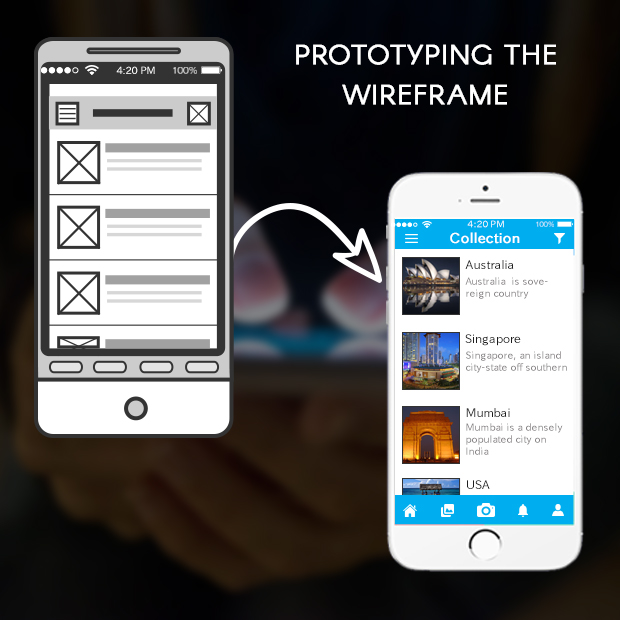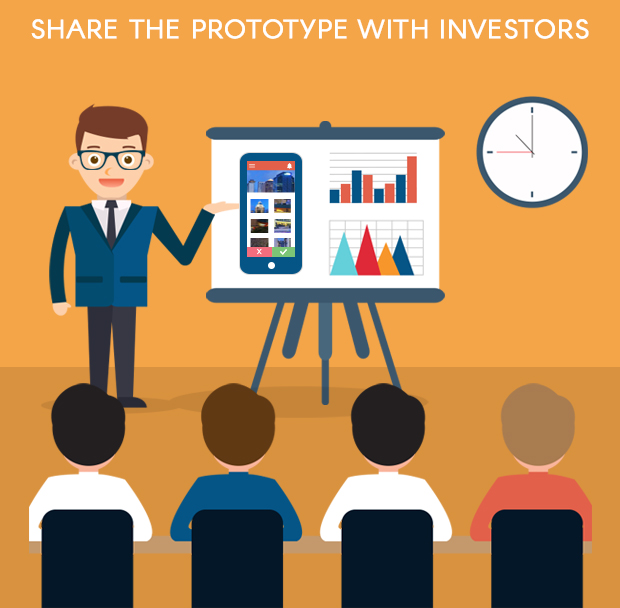This is what you need to read if you are looking to prototype your mobile app
Developing a mobile app from scratch is a complex task. It is involved with a number of complex processes such as – UX wire framing, estimation, setting the task, prototyping, UI design, animation, iOS development, testing, releasing and updating. Many stages are interconnected and it is impossible to imagine linear dependence. Some of the phases such as estimation come at different stages of mobile app development.
Prototyping a mobile app is one of the important stagesof mobile app development. Unfortunately, many app developers skip this step and jump directly into app development. As a result of this, mistakes are discovered only after the release. Prototyping help developers to avoid the risk of multiple modifications and unnecessary expenditure. Before you start reaping the rewards of your mobile app, you should consider some essential steps to prototype your mobile app.
Let’s walk through the best method to prototype a mobile app. These steps will help you realize your mobile app idea fully and minimize obstacles.
Know the objective of your mobile app
Before you jump into mobile app development, write down a simple definition of your app and ask yourself what problems your app aim to solve. This stage is all about understanding the main objective of your mobile app and its target audience. When you think about how to prototype a mobile app, you should consider if your app will solve a problem that target audience are experiencing. Whatever is the objective of your app, define it properly and think about if it is really beneficial.
Research the market
You should be able to convince your target audience through your app. This is where researching the market comes into play. You should be able to understand the end users in a better way to reduce the risk of redesigning the mobile app or designing a poor app. You can use some survey tools to gather responses to your questions. Collect both qualitative and quantitative data using these surveys before you make final decision. There are a number of free tools that provide you the information you need.
Once you have finished researching the market, you will get an idea of where your app is likely to fit. The next step is to create personas to visualizeyour key audience. Personas represent the major user groups of your app by expressing their needs and preferences. Creating personas is one of the important stages of prototyping process.
Create sketches of screens
Once you have understood the type of users and their requirements, you should figure out the high priority features of your app. Think from the point of user experience and begin with a few rough sketches of how the screens are going to look. The primary screens of an app are – profile, dashboard and features. You should be able to create sketches of screens in detail using a variety of free tools. There are lots of online sketching tools that take the pain out of working with repeated design elements.
Wireframe the app interface
The next step after creating sketches is to wireframe the interface. Wireframe is nothing but a low-fidelity outline of your app. It does not have any design elements or features — expect a few boxes, lines, words and descriptions.You can whip a fully functional wireframe using simple drag and drop prototyping tools. The best thing about these tools is that you can change the structure of your app to ensure best user experience and functionality.
Beside wireframe tools you can also use mobile templates and UI stencil to get a better idea of the elements you need in your app. Wireframing the app will give you better clarity of your app’s functionality. It even allows for early feedback at initial stages of app development.
Prototyping the wireframes
The next step is to put the wireframe in hands of people who want to test your app for feedback. This part of mobile app development gives you an opportunity to know your app and make necessary changes. The most common method of testing an app is to set up usability test and determine how useful the app is. At this stage, you will know whether the features are liked or disliked by the user.
Usability test provides all the valuable information such as – how the user is going to use the app, how they use the features, how well they interpret the labels etc. You should conduct multiple tests — as you learn from the users and tweak each version, until the functionality is optimal.
Modify the prototype
Once you have carried out usability test successfully and discovered pain points, the next step is to refine the prototype. When testing the app, you will come across a variety of problems that your users have experienced in their journey.
Consider it as a feedback from the users and stakeholders. Remember that it is not possible to take care of each and every comment. Your main aim should be to take care of the main concerns. Once you have the final files, you should update the Xcode prototype to make it look ‘Live’.
Share the prototype with investors
Don’t forget to share your prototype with investors and stakeholders. Fix an appointment with the investor and walk the potential investors through the prototype during the meeting, rather than sharing the prototype link before meeting.
Finally, the grey wireframes should be translated into final designs. You can hire a mobile app development agency or freelancer at this stage, if you don’t have the skills to implement the design. Spend some time talking to the app development agency about your objective and gauge their ability to execute your app.
Bottom line
By following the above steps, you can prototype a mobile app without much effort. However, it is not easy to move from app idea to sketches to prototypes. It is a time taking process and could take even months to prototype a mobile app.
Prototyping a mobile app is a completely new epitome, as the prototypes provide a simulation of final interaction between the app and user. Use the best mobile app prototyping techniques and focus more on creativity. You will surely be able to build mobile apps that offer unique user experiences.
Still have your concerns?
Your concerns are legit, and we know how to deal with them. Hook us up for a discussion, no strings attached, and we will show how we can add value to your operations!


